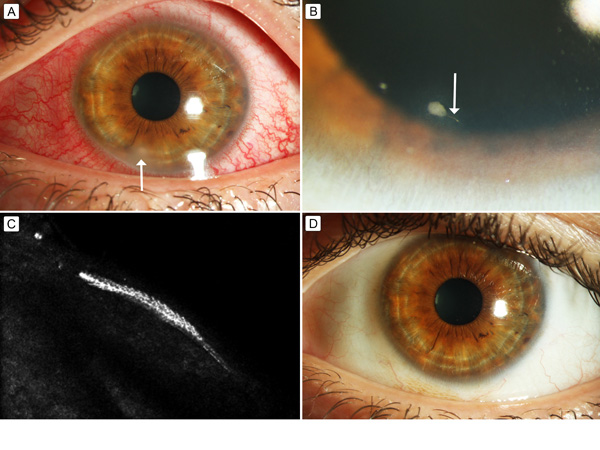
 |
 |
 |

Register
with DJO to receive personalized updates.
If you're already a
member, please sign in.
|
 |
 |
|
 |
 |
 |
 |
Tarantula hair keratitis Aug 31, 2021 Volume 26, Number 1 Caroline Wilde, MBChB, MRes, FRCOphth | Moorfields Eye Unit at St Georges University Hospital NHS Foundation Trust Tom Flynn, MBBS, BMedSci, PhD, FRCSI(ophth), FRCOphth, CertLRS | Moorfields Eye Unit at St Georges University Hospital NHS Foundation Trust; Moorfields Eye Hospital NHS Foundation Trust  A 39-year-old man who kept pet tarantulas presented to Moorfields Eye Hospital with a red, painful left eye. Examination revealed conjunctival hyperemia, a large inferior corneal keratic precipitate, and anterior chamber cells (A). He was prescribed hourly topical dexamethasone 0.1%. As the keratic precipitate resolved, a hairlike structure was revealed in the posterior corneal stroma (B). Intravital confocal microscopy revealed morphological features of a barbed, urticating tarantula hair, which was too small to be removed surgically (C). The patient required low-dose topical dexamethasone 0.1% for 9 months to control inflammation. He remains asymptomatic at 1 year, with a visual acuity of 20/20 and a quiet eye (D). Ophthalmia nodosa is an ocular inflammatory reaction caused by insect hairs or vegetative material. The tarantula sheds urticating hairs as a defense mechanism. These hairs are capable of penetrating deeply into the eye, causing local inflammatory reactions and, in severe cases, blindness. |
 |
 |
 |

|
|
 Welcome, please sign in
Welcome, please sign in  Welcome, please sign in
Welcome, please sign in